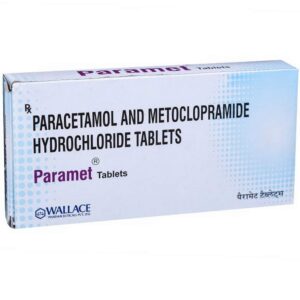PARACETAMOL + METOCLOPRAMIDE
Paracetamol: Paracetamol, also known as acetaminophen, is a commonly used medication for the relief of pain and reducing fever. It belongs to the group of drugs known as analgesics (pain relievers) and antipyretics (fever reducers). Paracetamol is available over-the-counter and in prescription-strength formulations.
Paracetamol works by inhibiting the production of certain chemicals in the brain that signal pain and increase body temperature. It is believed to work primarily on the central nervous system to alleviate pain and reduce fever. However, the exact mechanism of action is not fully understood.
The recommended dose of paracetamol depends on various factors, including the individual’s age, weight, and the severity of the condition being treated. Typically, the standard dosage for adults is 1-2 tablets (500-1000 mg) every 4-6 hours, not exceeding 4 grams (8 tablets) in a 24-hour period. It is important to follow the instructions provided by the healthcare professional or the package insert.
Paracetamol is generally well-tolerated when used at therapeutic doses. However, like any medication, it can have potential side effects. Common side effects may include gastrointestinal discomfort, nausea, vomiting, and allergic reactions such as skin rash or itching. In rare cases, it can cause severe skin reactions, liver damage, or blood disorders. Long-term and excessive use of paracetamol can lead to liver damage. It is always advisable to consult a healthcare professional and use paracetamol as directed.
It is important to note that paracetamol is not suitable for everyone, especially those with pre-existing liver disease or who are excessively consuming alcohol. It is crucial to consider other medications a person may already be taking to avoid potential interactions. It is recommended to consult a healthcare professional before starting any new medication or self-medicating with paracetamol.
Metoclopramide: Metoclopramide is a medication commonly used to treat conditions such as gastroesophageal reflux disease (GERD), nausea, and vomiting. It is available in different forms, including tablets, injections, and oral solutions.
The main mechanism of action of metoclopramide is by blocking dopamine receptors in the brain and digestive system, which helps to accelerate gastric emptying and reduce the likelihood of reflux. It also acts on serotonin receptors, further aiding in the treatment of nausea and vomiting.
The dose of metoclopramide can vary depending on the condition being treated, the patient’s age, and overall health. For GERD symptoms, the typical adult dose is 10-15 mg, taken orally up to 4 times a day. For nausea and vomiting, the usual adult dose is 10 mg, taken orally every 6-8 hours.
While metoclopramide is generally well-tolerated, there are some potential side effects to be aware of. The most common side effects include drowsiness, restlessness, fatigue, and headaches. Less common side effects may include movement disorders (such as involuntary muscle movements), depression, and allergic reactions. In rare cases, prolonged use of metoclopramide can lead to a serious condition called tardive dyskinesia, which causes involuntary movements of the face, tongue, and other body parts.
It’s important to note that metoclopramide should not be used in patients with a history of gastrointestinal bleeding, seizures, or certain types of tumors. It should also be used with caution in individuals with Parkinson’s disease, as it may worsen their symptoms.
As with any medication, it is necessary to consult with a healthcare professional before starting metoclopramide to ensure it is appropriate for the specific condition and individual.

